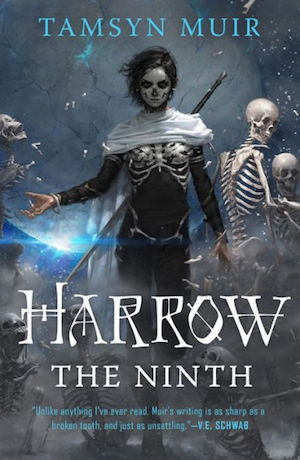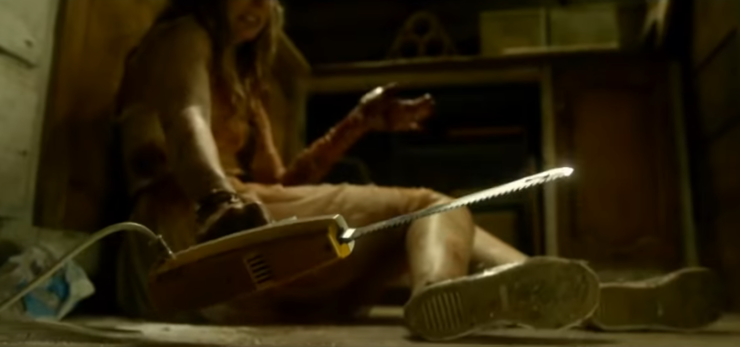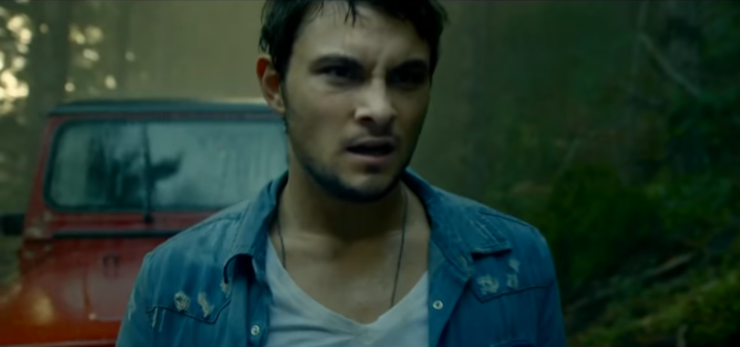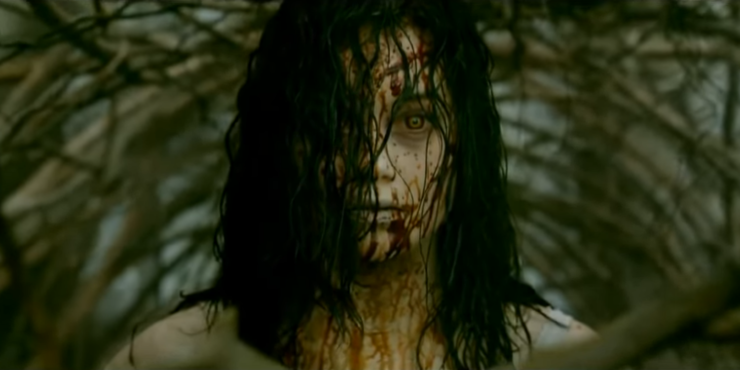Since Sam Raimi’s Evil Dead II is essentially a remake of The Evil Dead, the film that had launched his career six years earlier, you might think that yet another remake would be gory, superfluous overkill. And you wouldn’t be wrong. The 2013 Evil Dead reboot, directed by Fede Álvarez, takes the Raimi originals as a blueprint and borifies them by about 50%. In doing so, though, the newer Evil Dead highlights what was brilliant in Raimi’s work—and shows why a conventionally well-made movie and a good movie are often not the same thing.
If your focus is professionalism, Álvarez’s effort is in fact “better” than Raimi’s first film, and even in many ways better than his second. The acting is more accomplished: Jane Levy and Shiloh Fernandez as leads Mia and David aren’t fantastic performers, but their clear professionalism stands in stark contrast to Raimi’s first cast, which had the corny stiffness of a community theater production. Moreover, the script of the 2013 movie makes an effort to give the characters actual personalities, motivations, and backstories, so that they register as people, rather than just as monster fodder.
A group of friends has gathered at a remote cabin in the woods to try to help Mia go cold turkey and break her heroin addiction. Olivia (Jessica Lucas), a nurse, and Eric (Lou Taylor Pucci), an academic, have tried to help her quit before, while her semi-estranged brother David and his girlfriend Natalie (Elizabeth Blackmore) are participating in the intervention for the first time. When they arrive at their remote retreat, they find the cabin in disarray, and a mysterious book in the basement. Curious, Eric reads some passages out loud. This, as you’ve probably guessed, is a bad idea.
Buy the Book


Harrow the Ninth
In Raimi’s films, the titular evil dead can simply possess anyone at any time, which makes the subsequent action more hole than plot: Why doesn’t the irresistible force just infest everyone in the first five minutes and get it over with? Álvarez provides a more logical progression. After hearing something in the woods, Mia flees and is possessed first. In a nightmarishly visualized sequence, her own mouldering demonic double finds her and vomits out black, snake-like sludge, which slithers out and penetrates her in a too-literal soul rape. Once the leech has stuck onto her spirit, it creeps among the others, infecting them one by one as Mia spits fluids into them or bites them or kills them.
Like the plot, the themes of the movie are thought through more fully than in Raimi’s movies. The original Evil Dead and Evil Dead II don’t have much in the way of controlling metaphors; they’re just an excuse to toss around bodily fluids and watch evil, possessed hands beat their owners over the head with dinner plates.
Álvarez’s reboot has no shortage of grotesque images too; Mia slicing her own tongue with a knife lengthwise down the middle is a standout, and there are numerous shenanigans with a nail gun. But the movie is also about addiction as possession and a devouring of one’s own soul. The film can be read as a psychotic break brought on by withdrawal, with Mia consuming her friends and family and self in a nightmare of need and hate. The movie is obsessed with tearing and hacking off arms. That’s a tribute to Ash’s severed hand in Raimi’s films—but it’s also Mia imagining escaping her addiction by pulling off the limb where she’d normally inject herself.

The portrayal of addiction isn’t as controlled or as chillingly, bleakly clinical as it is in something like Kubrick’s The Shining. Still, there’s something to be said for Álvarez’s blatant pulp messiness. The grotesque image of heroin as intimate abuse of the self by black slime injection, or the buried dead Mia crawling out of the ground to come after her healthy twin once again—it’s true that’s not subtle. But heroin addiction is not an especially subtle disease.
Álvarez’s remake, then, can be said to be superior to Raimi’s originals in acting, in plot construction, and in control of thematic material. But Raimi’s movies are considered classics, and Álvarez’s is, at best, viewed as a midlly entertaining footnote to the franchise. Nor is this an injustice; Raimi’s movies are much more original and daring than Álvarez’s copy.
In fact, the same things that make Álvarez’s film more conventionally well-made are the things that make Raimi’s better. The first Evil Dead films are a wonder precisely because of their improvisatory, amateurish élan. Raimi feels like he’s making the films up as he goes along, tossing demons into unsuspecting actors as the mood takes him, his camera swooping here and there to infest a clock, a mantle, a door with random exuberant dread. The claymation special effects in Raimi’s movies aren’t realistic, but they have a visceral, joyously grotesque tactility that Álvarez can’t match even with several decades of improved horror FX verisimilitude. And Bruce Campbell as Ash has an awkward, hammy, bigger-than-life charisma that easily overshadows the performers in the 2013 version, even if they’ve obviously had more acting lessons and are given more realized characters to work with. Even the evil dead in Raimi’s films seem like they’re having more fun, dancing in the moonlight with their severed heads or shrieking in maniacal chorus, “Dead by dawn! Dead by dawn!” It’s goofy. It’s corny. And it’s way more memorable than the more professional and more predictable version Álvarez can manage.

Álvarez more or less recognizes this himself; his film is in part an argument that his film shouldn’t exist. The movie is framed as a kind of fated, unfortunate return. Early scenes establish that the summoning of the evil dead at the cabin has happened before, and just keeps happening. Someone comes to the cabin, reads the book, and the slaughter begins again. It’ s a kind of pop culture addiction, to pick up that same story and rob it of everything good, even when there’s a literal warning scribbled right there on the page telling you, Don’t read it! Don’t write it! Don’t say it!
There’s been an Evil Dead musical, a television series, and yet another film has just been announced. The deadites will keep coming back. But they’ll never capture the soul of Raimi’s original movies.
Noah Berlatsky is the author of Wonder Woman: Bondage and Feminism in the Marston/Peter Comics (Rutgers University Press).











What I think the makers miss is that Evil Dead II, in all it’s glory, was all at the same time a sequel, remake, and most importantly, parody of the original. I am reminded of the dreadful Nightmare on Elm Street remake that completely forgets the original story and what made it work.
Cabin in the Woods ruined this one for me. Five minutes in, I whispered to my wife “I hope it’s mermen this time” and we could not take it seriously… and it took itself much too seriously.
The original is cheesy, yes, but for me that’s the charm. One of my favorite effects ever is what I refer to as the Sam Raimi Effect – that awesome thing he used to do where he’d show some death and mayhem, then swing the camera towards a bare light bulb, only for the bulb to get splattered with blood while people screamed just off-screen. So good.
Noah Berlatsky, I suspect that you make very fair points but feel that somebody ought to point out that ‘never’ is a risky word to use in the context of remakes – while they’re rare as Hen’s Teeth, remakes that improve on the original are known and sequels that improve on the original are more common than that.
Hee hee, look at me, the voice of Old Man caution! (but in all fairness, if Fairy Tales and Horror and Urban Fantasy teach us anything it’s to be careful of what you speak … ).
Come on people. The reason the original was so good can be summed up in two words: Bruce Campbell. He was awesome, he’s still awesome, and he’ll continue to be awesome (can you tell I’m a fan
 )
)
I thought the remake was … fine? — the bit where the guy was pulling the needle out of his face still squicks me out — but largely unnecessary.
As always, you’re welcome to disagree with the original article or other commenters, but we ask that you keep the tone of the discussion civil. You are welcome to reframe comments that don’t meet our community standards in a more constructive way–the full moderation policy can be found here.